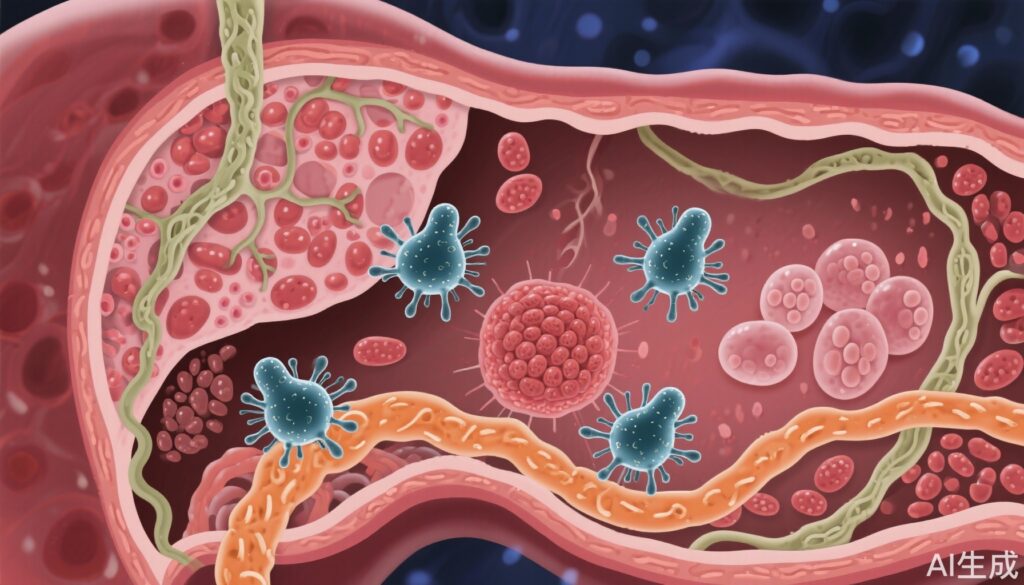Highlight
- B cells in tumour-adjacent tissue form mature tertiary lymphoid structures (TLS) associated with improved prognosis in iCCA.
- Tumour-infiltrating B cells exhibit an immature phenotype with impaired effector function and increased immunosuppressive properties.
- Interactions with cancer-associated fibroblasts (CAFs) and tumor cells, mediated by IL-6 and TGF-β, drive B-cell dysfunction in the tumour microenvironment.
- Restoring B-cell activation via dual blockade of IL-6 and TGF-β improves immune responses and correlates with better chemoimmunotherapy outcomes.
Study Background and Disease Burden
Intrahepatic cholangiocarcinoma (iCCA) is a lethal malignancy originating from the bile duct epithelium within the liver. It ranks as the second most common primary hepatic cancer and carries a grim prognosis due to late diagnosis, limited therapeutic options, and a complex tumour microenvironment (TME) that fosters immune evasion. Current systemic treatments, including chemotherapy combined with immune checkpoint inhibitors, have improved survival but remain effective in only a subset of patients. The interplay of immune cells within the TME, particularly the role of B lymphocytes, remains underexplored in iCCA. Understanding B-cell phenotypes and functions in this context is critical to identifying prognostic biomarkers and developing interventions to overcome tumour immunosuppression.
Study Design
This comprehensive study by Milardi et al. employed a multimodal single-cell analysis approach to profile B-cell compartments across tumour, peritumour, and peripheral blood samples from patients with iCCA. The B-cell interactome within the TME was interrogated in silico to elucidate cellular and molecular interactions influencing B-cell biology. Ex vivo co-culture experiments with cancer-associated fibroblasts (CAFs) and tumour cells evaluated the impact on B-cell differentiation and effector function. Additionally, peripheral B-cell dynamics were monitored during chemoimmunotherapy regimens in advanced iCCA to assess predictive biomarkers linked to treatment response.
Key Findings
The study revealed a spatial dichotomy in B-cell distribution and function within iCCA. B cells were abundant in tumour-adjacent, histologically normal tissues where they organized into mature tertiary lymphoid structures (TLS). The presence of TLS was strongly correlated with improved patient prognosis, reinforcing TLS as a positive immunological niche fostering anti-tumour immunity.
Conversely, B cells infiltrating the tumour were scarce and phenotypically immature. These tumour-infiltrating B cells demonstrated impaired effector functions, including diminished antibody production and antigen presentation capabilities, coupled with increased expression of immunosuppressive markers. Single-cell transcriptomic analysis identified downregulation of B-cell activating factor receptor (BAFFR) on peripheral B cells, a crucial molecule for B-cell survival and maturation.
Ex vivo co-cultures showed that CAFs and tumour cells release soluble factors that inhibit B-cell differentiation and promote an immunosuppressive phenotype. Mechanistically, interleukin-6 (IL-6) and transforming growth factor-beta (TGF-β) emerged as key cytokines mediating B-cell dysfunction. Pharmacological dual blockade of IL-6 and TGF-β signaling pathways successfully restored B-cell activation, differentiation, and effector functions in vitro.
Importantly, in patients undergoing chemoimmunotherapy for advanced iCCA, elevated frequencies of circulating BAFFR-positive B cells and the presence of hyperexpanded B-cell clonotypes were associated with superior therapeutic responses. These findings propose circulating B-cell parameters as potential predictive biomarkers of treatment efficacy.
Expert Commentary
This study provides pivotal insights into the immunosuppressive role of tumour-infiltrating B cells within the iCCA microenvironment, highlighting the complexity beyond traditional T-cell centric views of tumour immunity. The discovery that TLS in peritumour tissue portends better outcomes aligns with emerging evidence in other solid tumours, where TLS promotes local immune activation. The impaired function of intratumoural B cells, driven by CAFs and tumour-derived cytokines, underscores the multifaceted mechanisms by which the TME subverts anti-cancer immunity.
The therapeutic implications are significant. The data support targeting IL-6 and TGF-β pathways to revive B-cell-mediated immune responses as an adjunct to current chemoimmunotherapy strategies. The identification of circulating BAFFR+ B cells and clonal expansions as biomarkers could guide patient selection and monitor treatment efficacy. However, further validation in larger cohorts and mechanistic studies in vivo are warranted to confirm these findings and optimize combined modality therapies.
Conclusion
Intrahepatic cholangiocarcinoma is typified by an immunosuppressive TME that impairs B-cell maturation and function through direct cellular interactions and cytokine-mediated mechanisms. Disruption of B-cell homeostasis contributes to tumour immune evasion and impacts patient outcomes. Promoting mature TLS formation in peritumour tissue and restoring B-cell effector functions, especially through dual IL-6 and TGF-β blockade, offers promising avenues to enhance responsiveness to chemoimmunotherapy. Peripheral B-cell biomarkers may provide noninvasive tools for prognostication and treatment monitoring. Future clinical trials should incorporate strategies aiming to modulate tumour-associated B cells to improve iCCA management and patient survival.
References
Milardi G, Franceschini B, Camisaschi C, et al. Immunosuppressive contribution of tumour-infiltrating B cells in human intrahepatic cholangiocarcinoma and their role in chemoimmunotherapy outcome. Gut. 2025 Aug 31:gutjnl-2025-334861. doi: 10.1136/gutjnl-2025-334861. Epub ahead of print. PMID: 40889886.
Additional Recommended Reading:
1. Binnewies M, et al. Understanding the tumor immune microenvironment (TIME) for effective therapy. Nat Med. 2018;24(5):541-550.
2. Helmink BA, et al. B cells and tertiary lymphoid structures promote immunotherapy response. Nature. 2020;577(7791):549-555.
3. Monk S, et al. Molecular pathways and targeted therapies for cholangiocarcinoma. Nat Rev Gastroenterol Hepatol. 2021;18(9):557-565.



